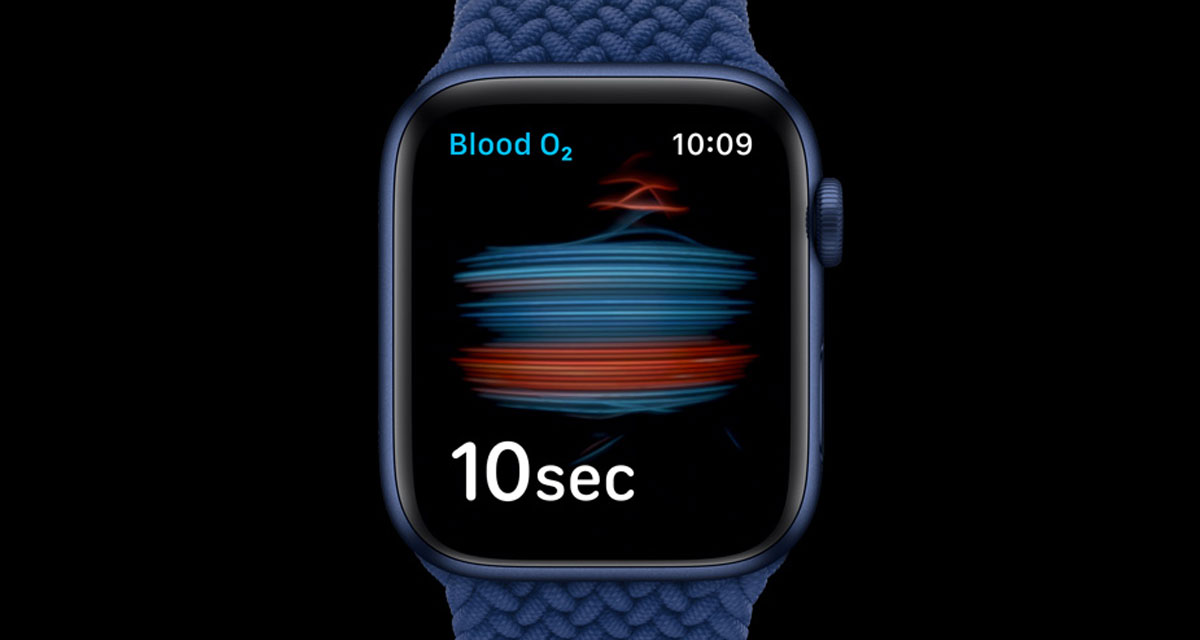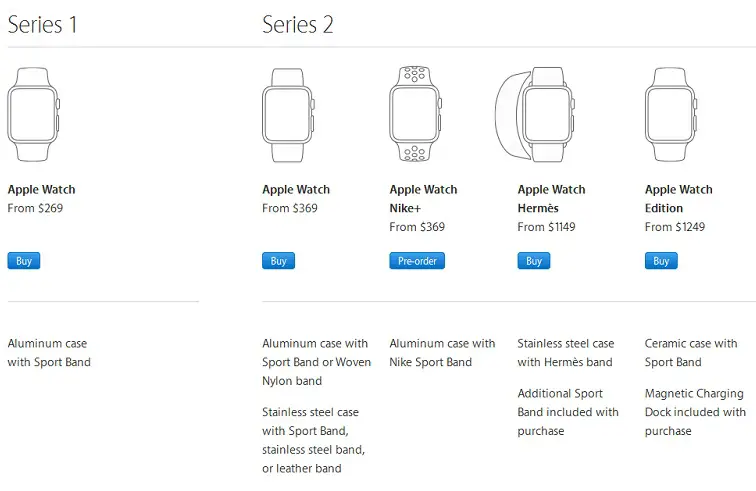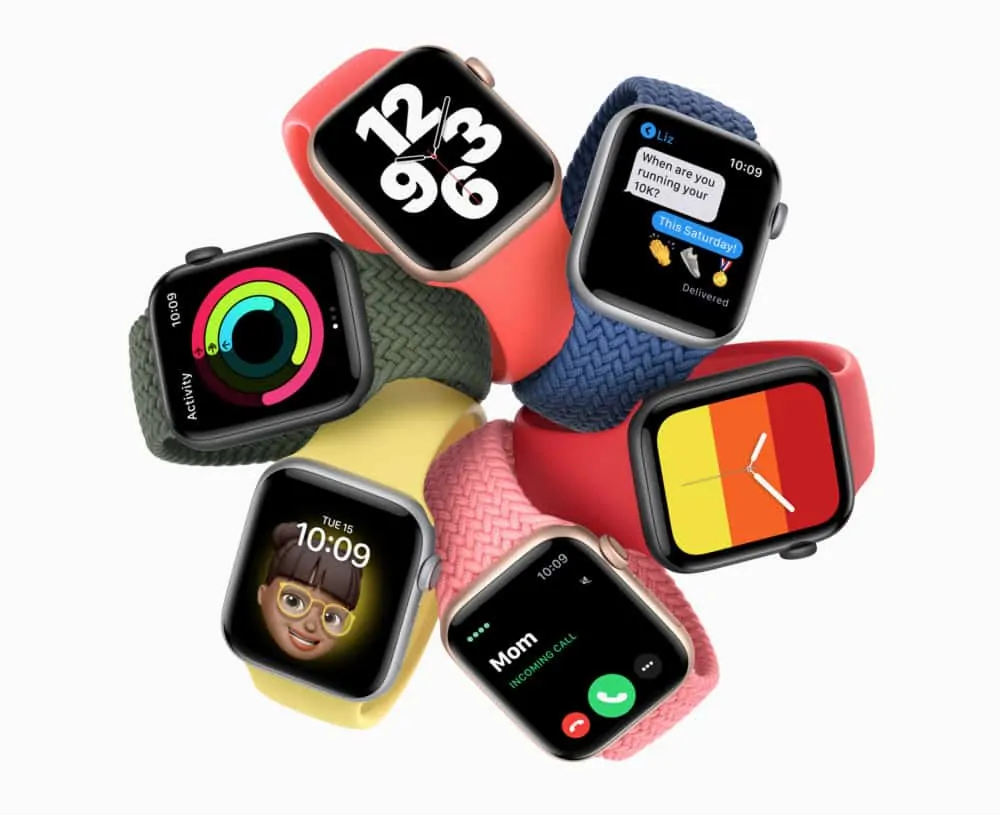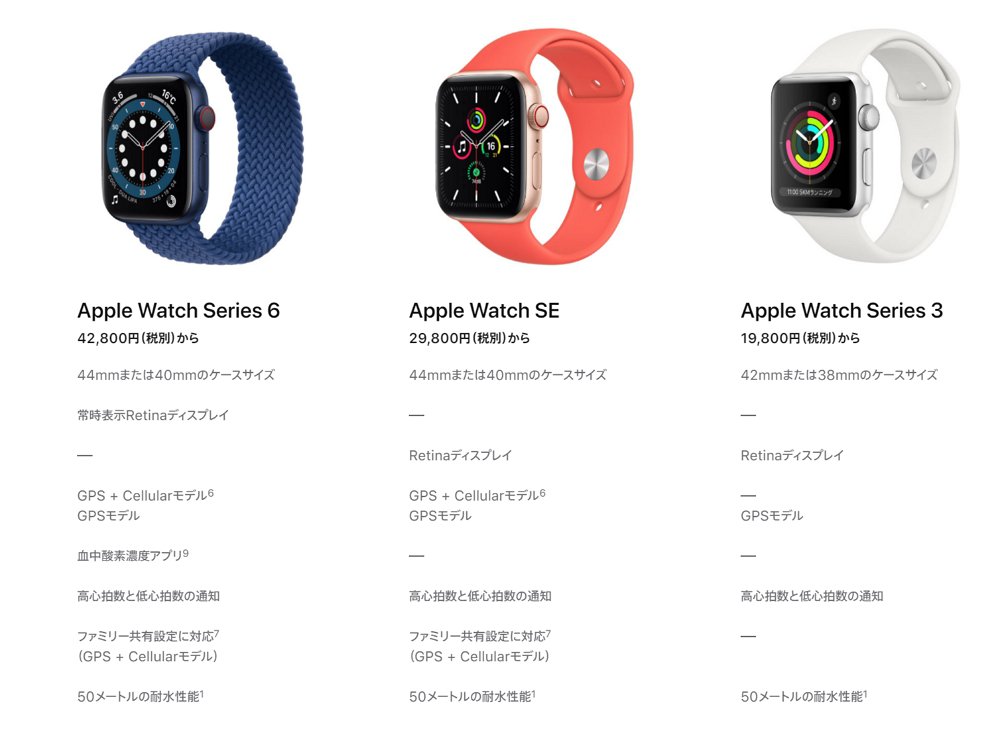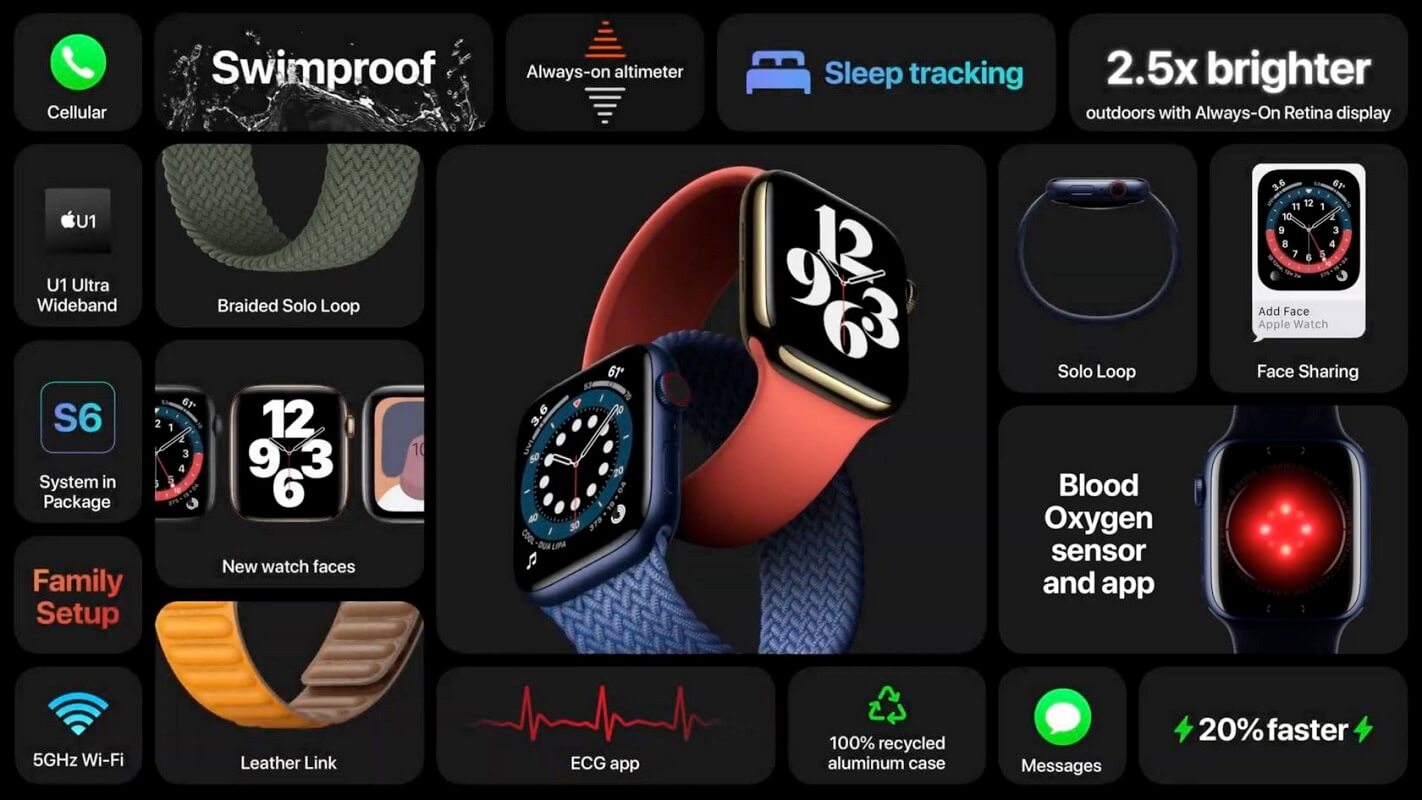The ECG system has received clearance from the United States Food and Drug Administration, a first ever for a consumer device, and is supported by the American Heart Association. This device can also detect falls and will automatically contact emergency services unless the user cancels the outgoing call. The microphone was moved to the opposite side between the side button and the digital crown to improve call quality. Other changes include the digital crown incorporating haptic feedback with the Apple Haptic Engine and includes the new Apple-designed W3 wireless chip.
The Apple Watch Series 7 offers the same suite of sensors as the Series 6. These include an accelerometer, a gyroscope, a heart rate sensor, a barometer, an always-on altimeter, a compass, an SpO2 sensor, and a VO2 max sensor. These sensors have a host of health and fitness tracking features, including blood oxygen monitoring, heart rate monitoring, sleep tracking, fall detection, workout tracking, and more. Additional features include a new S6 processor that is up to 20% faster than the S4 and S5, a 2.5× brighter always-on display, and an always-on altimeter. The Series 6 watch was updated with faster charging hardware such that it completes charging in ~1.5 hours. Force Touch hardware was removed, consistent with the removal of all Force Touch functionality from watchOS 7.
The Series 7 is also equipped with new hardware that enables ultra-rapid, short-range wireless data transfer at 60.5 GHz, though Apple has not fully explained this new functionality. The S7 SiP with 64-bit dual-core processor is up to 20% faster than the S5 in Apple Watch SE.12 The always-on altimeter detects your elevation in real time. You get the new Apple S7 SiP powering the Apple Watch Series 7, but there is no performance improvement here. Apple says this new processor is on par with the previous-gen S6 SiP in the Series 6.
The Series 7 supports dual-band Wi-Fi, Apple's U1 chip, and ultra wideband antennas. It has health sensors for blood oxygen and heart rate tracking as well as the hardware to record an ECG. Just like the Series 6, the new Series 7 also has an always-on altimeter that can track elevation changes constantly. The fall detection feature now also works while tracking workouts. TechRadar gave it a score of 4.5/5, calling it one of the top smartwatches, while criticizing the short battery life.
Digital Trends gave it a score of 5/5, calling it Apple's best product and praising the design, build quality, and software, among others, while criticizing the battery life. CNET gave it a score of 8.2/10, calling it the "best overall smartwatch around", while criticizing the battery life and lack of watch face options. T3 gave it a score of 5/5, calling it a "truly next-gen smartwatch" due to its thinner body and bigger screen compared to the Series 3, and health features. Now, although Apple will not officially sell the Apple Watch 6, users can still buy the previous-gen Apple Watch from third-party resellers until stocks last. So, which one should you get if you are in the market for an Apple Watch? Well, if you want the latest and greatest from Apple, we recommend you go for the latest Apple Watch 7.
The larger display, dust resistance, and faster charging are reasons enough to convince prospective buyers. Otherwise, if you don't care much about these minor upgrades and just want the Apple Watch experience, go with Apple Watch 6, which will now sell at reduced prices. It lacks fairly basic features like interval sessions and heart rate alerts. The 6 and 7 have the same array of sensors, including a blood oxygen sensor, an electrical heart sensor, a third-generation optical heart sensor, GPS, and a barometric altimeter. The Apple Watch Series 7 can only be paired with an iPhone, but the process is seamless. The watch installs compatible apps that are already on your phone so you can access them on your wrist directly.
For cellular models, the process of setting up LTE is simple and quick. Once done, you can stay connected using just LTE and leave your iPhone out of reach, for example while working out. Apple had also advertised faster charging speeds on the Series 7 at the time of its unveiling, but this feature is currently not available in India. It does everything the Series 6 did only slightly better, with a larger screen, a sleeker look, better durability and faster charging.
I'm not happy that Apple hasn't upgraded the battery life at all but it seems, until something drastic happens, that Apple Watch users are stuck with one to two days between charges. Apple has also made some significant improvements to battery life and charging on the Apple Watch Series 7. The company claims that the new smartwatches offer 18-hour all-day battery life, along with 33% faster charging than the previous model. Speaking of the battery, the Series 7 promises the same runtime as its predecessor, which is to say, about 18 hours. I generally found myself getting about half a day more from the new watch than the SE, despite the lack of an Always On display on the SE.
The Series 7 usually stuck around for a day and a half, almost two, with the screen set to Always On, and tracking between three and five workouts. I also used the device to send plenty of messages and map my walks while I ran errands with the GPS on. That endurance is impressive given the larger screen, but it's worth noting that I haven't used the watch for sleep tracking yet. So, the difference between the two generations of Apple's smartwatches boils down to the importance placed on the larger display, the reduced charging time, water-and-dust resistance, and color options.
If one has already made up one's mind, there is no persuading otherwise. It's worth noting that all of these features - except the always-on altimeter - can be found on the Series 4 and 5 too. Overall, the Apple Watch Series 7 is a minor upgrade over the Apple Watch Series 6, offering larger displays and casing sizes, new color options, improved durability, the S7 chip, and faster charging. These features are mostly iterative improvements rather than major reasons to upgrade, and the Series 7 does not add any new functionality.
Apple claims 18 hours of battery life on the Apple Watch Series 7, and I was able to get about a day and a half worth of use on a single charge. It was set to monitor my heart rate throughout the day, with the always-on display mode enabled, and SpO2 tracking on by default. During this time, the watch was connected to my iPhone at all times. I did also manage to get just about two days' worth of battery life with the always-on display switched off. Using the Series 7's cellular capability resulted in a drop in battery life as I expected. Initial reviews for the device have been generally positive with some caveats.
Reviewers praised the watch's potential ability to integrate into everyday life and the overall design of the product, but noted issues of speed and price. Many reviewers described the watch as functional and convenient, while also noting failure to offer as much potential functionality as preceding smartphones. Farhad Manjoo of The New York Times mentioned the device's steep learning curve, stating it took him "three long, often confusing and frustrating days" to become accustomed to watchOS 1, but loved it thereafter.
Some reviewers also compared it to competing products, such as Android Wear devices, and claimed "The Smartwatch Finally Makes Sense". He concluded that there is no "killer application" so far besides telling the time, which is the basic function of a wristwatch anyhow. Force touch technology has been removed in Watch Series 6 and Watch SE. The watch also has a side button which can be used to display recently used apps and access Apple Pay, which is used for contactless payment. The watch then reverts to its original mode when recharged or after holding down the side button.
To make use of the larger display, Apple has redesigned the user interface by optimising the UI elements. Courtesy the watchOS 8, the Watch Series 7 gets larger menu titles and buttons in apps like Calculator, Stopwatch, Activity, and Alarms. Besides, there are two new watch faces exclusive to the Apple Watch Series 7. There is a new Contour face with an animated dial on the edge of the display that animates to emphasise the current hour details. The new redesigned UI and watch faces take advantage of the increased display size and profile to make the display intuitive to interact with.
Besides, there are two additional larger font sizes for easy readability of the on-screen content. Apple has also included a new QWERTY keyboard with swipe-to-type feature. Though a good addition, the screen still is not big enough to make text entry easier and faster, especially if you have fat fingers. There is no smartwatch that complements the iPhones the way Apple's own watches do, even if they are not perfect. Therefore, even if the new models do not bring any significant upgrades over the previous-generation models, they still make a compelling buy for iPhone users looking to upgrade to a new model. While you shouldn't expect a bump in battery life for the Series 7, it does juice up faster than earlier models thanks to a new charging architecture and a Magnetic Fast Charger USB-C Cable.
Apple says it charges 33% faster than the Series 6—just 45 minutes of charging will take the watch from dead to 80% battery life. And eight minutes on the charger offers eight hours of juice for overnight sleep tracking. This is Apple's most powerful smartwatch yet and it features upgrades like a bigger screen, dust resistance, faster charging and more. But taking a deeper look at the differences between the Watch Series 7 andSeries 6, it doesn't seem like a major upgrade. We tell you what has changed and what remains the same in this detailed comparison. Secondly, in the case of the Series 7 , the Digital Crown has an electrical heart rate sensor built into it, which is in addition to the optical heart rate sensor on the underside of the watch.
The Watch Series 7 also has a blood oxygen sensor, like the Series 6, and it has reduced bezels surrounding the display, as well as an IPX6 dust resistance. The Apple Watch Series 7 doesn't have an official release date yet, and by all indications, it's pretty similar to last year's model. The most significant difference is the Apple Watch Series 7 has a bigger screen and thinner bezels, making the Apple Watch Series 6 screen look smaller side-by-side.
Not to mention that the Series 7 comes in two slightly bigger case sizes — 41mm and 45mm — making the device just a bit bigger than the Series 6. The Apple Watch Series 7 is a minimal upgrade on the inside, but the new larger display with thinner bezels looks gorgeous. While it has the same battery life as last year's model, the Series 7 has a USB-C charging cable included in the box that charges the watch up to 33% faster, so you'll spend less time juicing up than before.
Apple finally announced on launch day that the Series 7 has the same S6 processor as the Series 6 (though it's calling it the S7 due to some slight changes). But it's notable in that it's the first time Apple has 't updated the processor in a new model. The watches also both have the same LTE chip for cellular connectivity, so if you're looking for 5G, you'll need to wait for the Series 8. For users who already have an Apple Watch Series 6, the Series 7 probably does not offer enough to warrant upgrading unless you particularly want a larger display, faster charging, or improved durability. The design changes and new features are iterative rather than transformative, and there are no new major capabilities, so many Series 6 users may prefer to wait a little longer to upgrade.
The Apple Watch Series 7 offers a number of upgrades and improvements on 2020's Series 6, offering a larger display with bigger casing sizes, faster charging, and the S7 chip, for a price starting at $399. Apple hasn't provided any significant additions to the health features on the Apple Watch Series 7. The Apple Watch Series 7 offers blood oxygen saturation tracking using a built-in Blood Oxygen sensor. It is also capable of tracking heart rate using an electrical heart rate sensor that was first introduced on the Apple Watch Series 4.
The smartwatch can also detect atrial fibrillation and can provide an electrocardiogram report, same as the Apple Watch Series 6. Apple has announced a refreshed Watch Series 7 with a 1 mm larger display, new case colors, and watchOS 8. The new Watch Series 7 is now much more durable, includes new fitness apps such as Mindfulness, and riding fall detection.
The Watch Series 7 also charges 33% faster compared to the Watch Series 6. Other than this, the Apple Watch 7 display is also 70% brighter vs the Apple Watch 6 display in terms of the always-on display. That means you will be able to check the time more easily when idle in comparison to the previous-gen model.
Apple Watch 6 And 7 Compare Plus, Apple has redesigned some of the UI elements on the Series 7 to utilize the larger screen area. For instance, you now have larger on-screen buttons, can read long texts in one go, new in-depth activity complications, and quirky watch faces to match the larger curved display on the Series 7. Moreover, unlike the previous-gen model, Series 7 features a full keyboard with swipe support to input texts. Whether the charging update represents an important improvement really depends on how you use your Apple Watch.
If you take it off when you go to bed and slap it on the charger, you'll hardly notice the change. Another factor that makes it hard to say whether the battery life is definitely better is the faster charging. Apple promises that it's 33% faster, and I've seen it charge from 30% to 80% in half an hour, which I would've expected to take about 45 minutes before, so I think the promise is bang on. Apple also says that 8 minutes of charging before bed gets you enough juice for 8 hours of sleep tracking, even if it's empty.
The Apple Watch SE, in contrast to its more expensive counterparts, packs an optical heart rate sensor, fall detection, an always-on altimeter. Unlike the last few generations of flagship wearables, it does not have a blood oxygen sensor or an electrocardiogram. Compared to the Watch SE though, the Series 6 only adds an always-on display, ECG, blood oxygen monitoring, a faster processor and the U1 chip. For some, the improved processor, ECG and blood oxygen functionality, Always-On display and U1 chip could be the five features you needed to take the smartwatch plunge, but for others, the Watch SE will more than suffice. In terms of the Series 7, a bigger display is added, but otherwise the features are almost identical to the Series 6.
Thanks to the larger display on the Series 7, it also offers a full keyboard with QuickPath for replying to messages. The Apple Watch Series 7 is Apple's flagship smartwatch for a reason. Not only does it have a bigger screen than earlier Apple Watches, it's also more durable thanks to a dust and crack-resistant design. It has a blood oxygen and electrocardiogram sensor and is available in either a 41mm or 45mm case size. You can also choose a cellular or LTE model that lets you take calls and answer messages from your wrist without your phone, although that does cost extra. There is also the Apple Watch Series 3, which Apple sells for $199.
This older model offers substantially fewer features and has a smaller screen. The Apple Watch Series 3 is still a capable device, with 8GB of storage, water-resistance up to 50 meters, an altimeter, Emergency SOS, and an optical heart sensor. Functionally, it is more pared back than the Apple Watch SE, being thicker with larger bezels. The Watch Series 7 has a new charger, complete with fast charging, and is easily recognizable compared to the older versions due to the silver case. It provides an 80% charge in 45 minutes according to Apple, but when plugged into the Apple fast charger, it exceeds this, getting to about 88% in that time. There is also has a handy feature where an eight-minute charge will return eight hours of sleep tracking.
I'm only scratching the surface here, as I haven't mentioned sleep tracking, dozens of workout plans, Apple's Fitness+ service, noise alerts, and the mindfulness app yet. If you have used an Apple Watch in the past, the experience will be very similar. Pressing the digital crown opens up the app drawer on the Apple Watch, and this can be set to zoom in/out and also be used to scroll through menus and notifications.
Apple has also added a sensor on the digital crown for measuring ECGs using Apple Watch Series 7. I found the watch to be quick to respond to touch inputs, and the bigger display compared to previous models did make content a little easier to read. The Contour watchface highlights the new rounded screen edges of the Series 7, while the Modular Duo face shows details of three complications at once. The Apple Watch has been one of the best smartwatches in the industry, and each new generation becomes the wearable of choice for those using an iPhone. Apple Watch has been improved over the years, with multiple generations each bringing in new features and capabilities.
So is the Apple Watch Series 7 a big leap over the Series 6, or just a small iterative step? The Series 7 offers the same 18-hour battery life as the 6, but with 33% faster charging. Because I don't typically sleep in my Watch, a full charge gives me two full days of use. Unlike the 6, I don't have to wait as long for the Watch to be ready to go. Though the differences between the Series 6 and 7 seem minor, it's worth a reminder that most people who own last year's model likely aren't looking to upgrade yet anyway.
